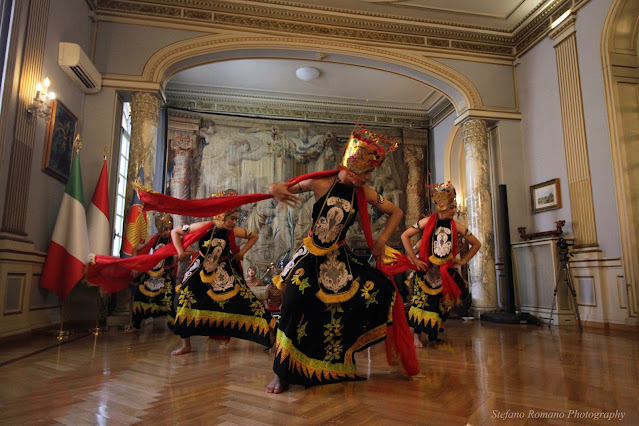 |
| Krida Budaya. KBRI Rome. Rome, 25 August 2023 |
In the wonderful hall of KBRI Rome, the Embassy of Indonesia, the young artists of Krida Budaya performed at the end of their European tour in Spain, France, and Italy, first in Castrovillari and then in Rome, before their return to their homeland, seizing also the fortuitous coincidence of being able to perform a few days away on 17 August, Indonesia's Independence Day.
As stated on their site:
“Krida Budaya is a student organization on
behalf of Universitas Indonesia focusing on preserving and developing folklore
dances and music. In the course of time, Krida Budaya has grown into a
phenomenal dance group that is focused on wider dance perspectives.”
Before their performance, there was an
auspicious prayer in the make-up and change of clothes room, with some of the
embassy employees.
Then there was the performance which was
divided into five dances from different areas of Indonesia and an instrumental
part, to show the ethnic-cultural variety of the land of 17,000 islands, before
the admiring eyes of the head of the Embassy, Deputy Chief Minister Lefianna
Hartati Ferdinandus, and the Ambassadors of Malaysia, Myanmar, the Philippines
and Thailand, more diplomats than other Embassies, and the Italians who
accepted the invitation.
The dances started with “Kancet Papetai” from
East Borneo.
Nature is our lord; our duty is to protect and
preserve it, countering those who harm their ancestral legacy. Pure Dayak
tribal energy brings a piece of the forest into the tapestry and stucco
rooms of the Embassy.
The second dance from East Java: “Gandrung”.
This dance draws inspiration from Gandrung
Marsan, a male dancer who enhanced his development. The strong and assertive
character of the movements is underlined by the mustache that each dancer
wears.
Beauty, grace, but inner goodness surpasses
surface appearances symbolized by the mask being put on and taken off.
A musical interlude of a Nusantara song,
specifically Minang and NTT.
The next dance is “Tor-Tor Tandok”, from North
Sumatra, expressing the happiness of Batak women when harvesting rice.
The last dance is one of the most famous in
Indonesia: “Piring” from West Sumatra. This dance reflects agrarian life's
harmony with nature featuring acrobatic moves on plates, expressing their
connection to the land.
After the lunch break, with typical Indonesian food offered by the Embassy, the dance Workshop of the same students took place in the early afternoon, which was attended by both people from the public and the staff of the Embassy, for a cheerful and lively finale.
We hope to be able to see more similar events
that reveal the cultural richness of Indonesia which is, unfortunately, still too
little known here.
Universitas Indonesia, Pondok China, Beji, Kota Depok,
Jawa Barat 16424, Indonesia
https://www.kridabudaya.com/






















They are truly amazing students. Not every Indonesians have those priviledge to watch the dance performanced directly. So congratulations❤
ReplyDeleteMy pleasure to show through my photos 🙏
DeleteNice interesting sharing on others custom and culture which almost look alike one of the state in my country i.e. the Ngajat dance in Sarawak.
ReplyDeleteYour photos never failed to narrate them all as always.
Happy to know it 😊✌️
DeleteBeautiful pics so warming 🥰
ReplyDeleteThank you 😊
DeleteI am awstruck by the greatness of their traditional dances and the expertise of the dancers.
ReplyDeleteReally thanks 🙏
Delete